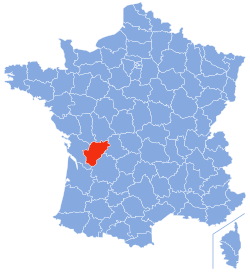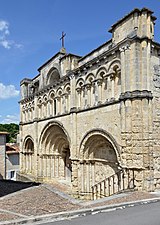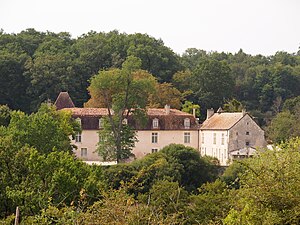Charente
You can help expand this article with text translated from the corresponding article in French. (December 2008) Click [show] for important translation instructions. |
Charente | |
|---|---|
 Prefecture building of the Charente department, in Angoulême | |
 Location of Charente in France | |
| Coordinates: 45°50′N 0°20′E / 45.833°N 0.333°E | |
| Country | France |
| Region | Nouvelle-Aquitaine |
| Prefecture | Angoulême |
| Subprefectures | Cognac Confolens |
| Government | |
| • President of the Departmental Council | Philippe Bouty[1] (DVG) |
| Area | |
| • Total | 5,956 km2 (2,300 sq mi) |
| Population (2021)[2] | |
| • Total | 350,867 |
| • Rank | 68th |
| • Density | 59/km2 (150/sq mi) |
| Time zone | UTC+1 (CET) |
| • Summer (DST) | UTC+2 (CEST) |
| Department number | 16 |
| Arrondissements | 3 |
| Cantons | 19 |
| Communes | 363 |
| ^1 French Land Register data, which exclude estuaries, and lakes, ponds, and glaciers larger than 1 km2 | |
Charente (French: [ʃaʁɑ̃t] ; Saintongese: Chérente; Occitan: Charanta [tʃaˈɾantɔ]) is a department in the administrative region of Nouvelle-Aquitaine, south western France. It is named after the river Charente, the most important and longest river in the department, and also the river beside which the department's two largest towns, Angoulême and Cognac, are sited. In 2019, it had a population of 352,015.[3]
History
[edit]Charente is one of the original 83 departments created during the French Revolution on 4 March 1790. It was created from the former province of Angoumois, and western and southern portions of Saintonge.
Prior to the creation of the department as a single unit, much of it was commercially prosperous thanks to traditional industries such as salt and cognac production. Although the river Charente became silted up and was unnavigable for much of the twentieth century, in the eighteenth century it provided important links with coastal shipping routes both for traditional businesses and for newly evolving ones such as paper goods and iron smelting.[citation needed]
The accelerating pace of industrial and commercial development during the first half of the nineteenth century led to a period of prosperity, and the department's population peaked in 1851.[4] During the second half of the nineteenth century Charente, like many of France's rural departments, experienced a decline in population as the economic prospects available in the cities and in France's overseas empire attracted working-aged people. Economic ruin came to many in the Charentais wine industry with the arrival in 1872 of phylloxera.[citation needed]
During the twentieth century, the department with its traditional industries was adversely impacted by two major world wars, and in the second half of the century, it experienced relatively low growth. The overall population remaining remarkably stable at around 340,000 throughout the second half of the twentieth century, although industrial and commercial developments in the conurbation surrounding Angoulême have added some 10,000 to the overall population during the first decade of the twenty-first century.[citation needed]
The relatively relaxed pace of economic development in the twentieth century encouraged the immigration of retirees from overseas. Census data in 2006 revealed that the number of British citizens residing in the department had risen to 5,083,[5] placing the department fourth in this respect behind Paris, Dordogne and Alpes-Maritimes.[6]
Geography
[edit]It is largely part of the Aquitaine Basin, with the north-eastern part in the Massif Central. The Charente flows through it and gave its name to the department, along with Charente-Maritime. It is composed with the historical region of Angoumois and contains part of the regions of Saintonge, Limousin, Périgord and Poitou.
The department is part of the current region of Nouvelle-Aquitaine. It is surrounded by the departments of Charente-Maritime, Dordogne, Haute-Vienne, Vienne and Deux-Sèvres. The southernmost “major” town (town with over 1,000 people) in the Charente is Chalais.
Principal towns
[edit]The most populous commune is Angoulême, the prefecture. As of 2019, there are 9 communes with more than 5,000 inhabitants:[3]
| Commune | Population (2019) |
|---|---|
| Angoulême | 41,603 |
| Cognac | 18,670 |
| Soyaux | 9,761 |
| La Couronne | 7,764 |
| Saint-Yrieix-sur-Charente | 7,381 |
| Ruelle-sur-Touvre | 7,305 |
| Gond-Pontouvre | 6,119 |
| L'Isle-d'Espagnac | 5,626 |
| Champniers | 5,149 |
Demographics
[edit]The inhabitants of the department are called Charentais or in feminine, Charentaise.
Population development since 1791:
|
| ||||||||||||||||||||||||||||||||||||||||||||||||||||||||||||||||||||||||||||||||||||||||||
| |||||||||||||||||||||||||||||||||||||||||||||||||||||||||||||||||||||||||||||||||||||||||||
| source:[7][8] | |||||||||||||||||||||||||||||||||||||||||||||||||||||||||||||||||||||||||||||||||||||||||||
Politics
[edit]The President of the Departmental Council is Philippe Bouty of the Miscellaneous left (DVG), elected in July 2021.
| Party | seats | |
|---|---|---|
| • | Socialist Party | 15 |
| Union for a Popular Movement | 6 | |
| Miscellaneous Right | 6 | |
| • | Miscellaneous Left | 6 |
| • | French Communist Party | 2 |
National Assembly representatives
[edit]Economy
[edit]Cognac and pineau are two of the major agricultural products of the region, along with butter. The Charentaise slipper (a type of slipper made from felt and wool) is another well-known traditional product.
Tourism
[edit]- Abbey of La Couronne
See also
[edit]- Cantons of the Charente department
- Communes of the Charente department
- Arrondissements of the Charente department
- Kaolin deposits of the Charentes Basin
Sources
[edit]- ^ "Répertoire national des élus: les conseillers départementaux". data.gouv.fr, Plateforme ouverte des données publiques françaises (in French). 4 May 2022.
- ^ "Téléchargement du fichier d'ensemble des populations légales en 2021" (in French). The National Institute of Statistics and Economic Studies. 28 December 2023.
- ^ Jump up to: a b Populations légales 2019: 16 Charente, INSEE
- ^ Jean Combes (dir.) et Michel Luc (dir.), La Charente de la préhistoire à nos jours, Imprimerie Bordessoules, coll. "L'histoire par les documents", 1986, 429 p. (ISBN 2-903504-21-0)
- ^ "Près de 13 000 Britanniques ont choisi de vivre en Poitou-Charentes - e.décim@l | Insee". www.insee.fr.
- ^ La Charente libre du 4 janvier 2010
- ^ "Historique de la Charente". Le SPLAF.
- ^ "Évolution et structure de la population en 2016". INSEE.
- ^ Nationale, Assemblée. "Assemblée nationale ~ Les députés, le vote de la loi, le Parlement français". Assemblée nationale.
External links
[edit]- . Encyclopædia Britannica. Vol. 5 (11th ed.). 1911.
- (in French) Prefecture website
- (in French) Departmental Council website









